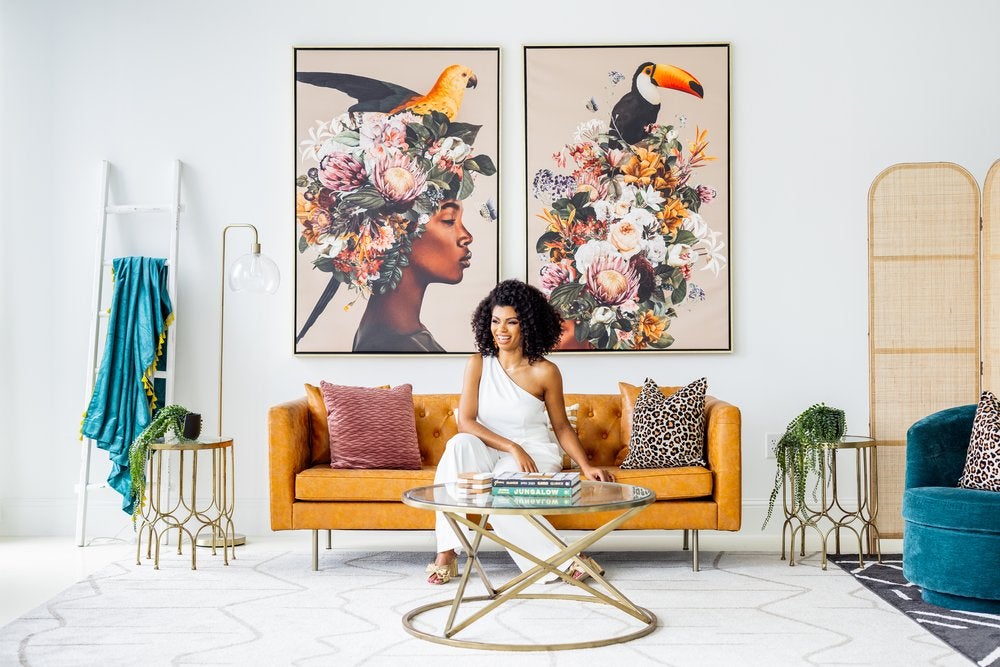In a new series, Ask an Influencer, Business of Home explores the creator economy. This week, we spoke with Amber Guyton, blog creator and interior designer of Blessed Little Bungalow.
Back in 2016, Guyton was a full-time fintech marketer when the purchase of a new home in San Antonio, Texas (affectionately known as her Blessed Little Bungalow) inspired her to chronicle her DIY journey. As her audience grew over the years, so did her business opportunities: lucrative brand partnerships and a new cohort of e-design clientele soon allowed Guyton to ditch her day job and go all in on design. Now based in Georgia, her business spans content creation, e-design and traditional design services—all anchored by her social media presence, which totals 102,000 followers. In BOH’s inaugural Ask an Influencer interview, Guyton shares her organic approach to initiating brand partnerships and explains why an unabashedly authentic approach has fostered a faithful community of followers.
What was your path into design?
In 2015, I had just finished my MBA, and I moved from Atlanta to San Antonio for a new corporate role. I bought a new house there—I closed on a Monday and had the entire place decorated by that weekend because I had already been purchasing things. I was super excited. When my family and friends came to visit, they were in awe. They were expecting to help me unpack! And my mom—this phrase sticks with me so much—she was like, “So when are you going to do this for real?” I was like, “What do you mean? I already have a career.” I had a job in marketing and financial services, and I was really passionate about that. But she felt like this talent was something that shouldn’t go to waste, regardless of my other career goals.
I decided to start a blog about my house. I figured that if I wasn’t going to do this for money, at least I could do it for fun as a creative outlet. I started in April 2016 and did that for five years. Eventually, people started inquiring about me helping them with their homes, and it just organically grew as a hobby/side hustle until last summer, when I decided to leave my tech job.
What prompted your career change?
I had moved to San Francisco in 2019, and then during the pandemic, my company became remote-first, so I decided to move back to Atlanta and buy a house here. And after being back here for a while, I decided to take the leap of faith and jump full-time into Blessed Little Bungalow. I’ve been a full-time interior designer/content creator since June 2021.
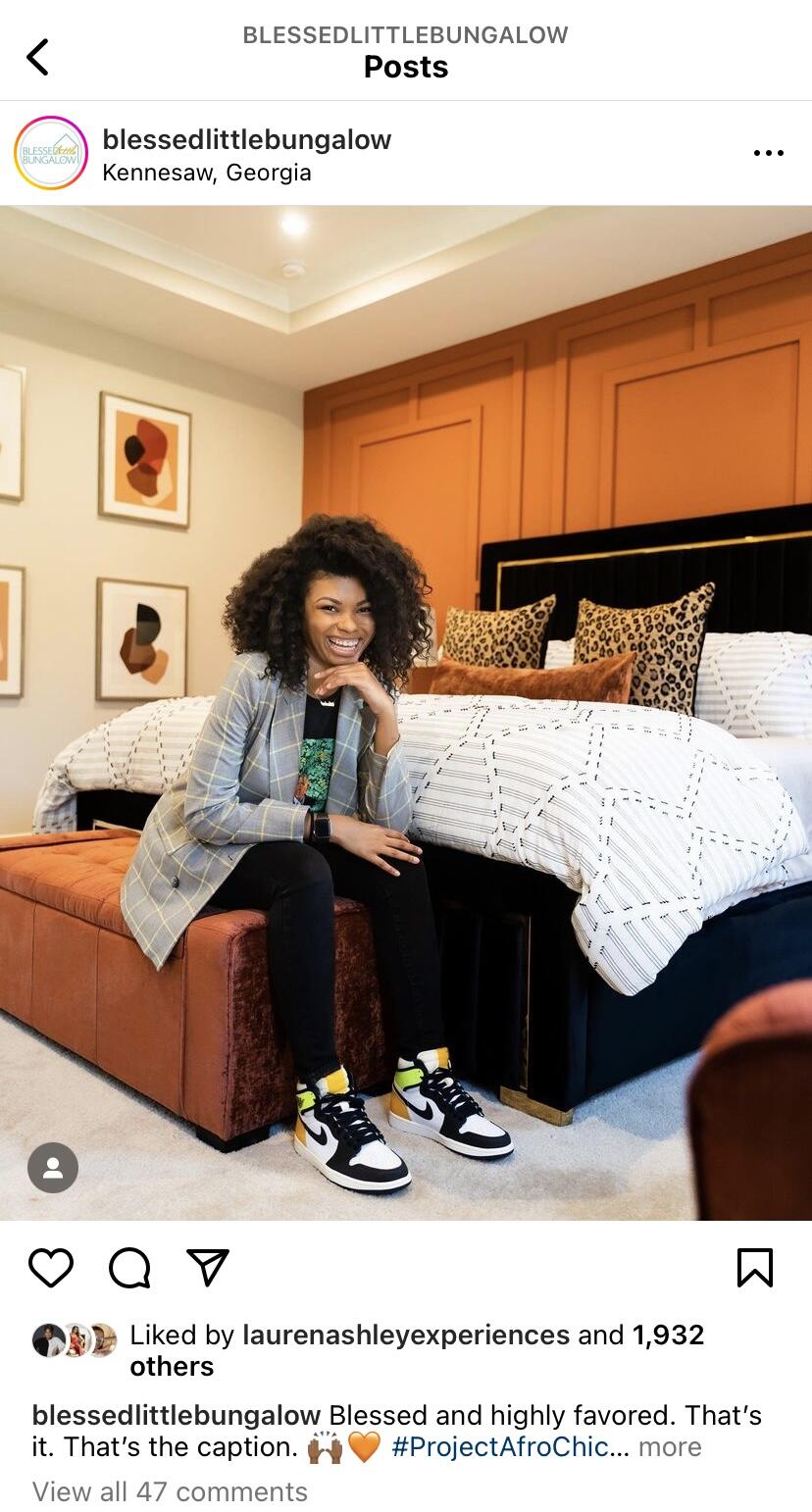
What was your approach when you first started blogging?
I tried my best from the very beginning to be my authentic self. Interior design can feel kind of stuffy, and I suffer from a good bit of impostor syndrome. I felt like, “There’s no reason to pretend that you know what you’re doing—just be real about your process, the colors you like, the things that may be controversial or not.” Even beyond the before-and-afters, I’m very real with my audience about things like poor client experiences, impostor syndrome or why I didn’t go to High Point Market for several years because I felt like I didn’t belong. I talk about firing clients and clients firing me, the struggle of entrepreneurship, and how social media glamorizes it.
I’ve talked about the good, bad and ugly, and that’s what’s really fueled my engagement and my tribe. You can have a lot of followers, but are those people actually listening to you? Are they talking with you? Do they trust you? Social media does a great job of humanizing not just me and my business, but the entire experience of designing a home and setting expectations—you know, “All of these things that you see HGTV tackling in a 30-minute episode can take two years, and are you OK with that?”
When did you start approaching your social media with a strategy in mind?
The only thing I wanted to make sure I was disciplined about was consistency. That meant posting twice a week, or twice a day, and helping set expectations for my audience, because when I started posting more frequently, it definitely helped increase my followers.
Do you follow a content schedule?
One thing that annoys me about influencers sometimes is that it can feel like you’re trying to sell me something every five minutes. Yes, I get it, you’ve got to pay your bills, but I am not coming to you for you to sell things to me. I’m coming to you because I want you to influence me in other ways, without necessarily [including] my pockets. Sometimes, it can feel very sales-y, and I didn’t want to do that. There are do’s and don’ts that I abide by, and that’s one of the don’ts as far as content strategy.
On Motivation Monday, sometimes I do a quote or a pretty portfolio photo or lifestyle photo of myself. On Transformation Tuesday, I do a before-and-after, and sometimes [I post on] Wallpaper Wednesday—so that content was around a hashtag. Otherwise, I try to keep an even balance between posting my work, my day-to-day life and real, no-BS moments like, “Today drained me. Going to my living room to curl up with a good book and a glass of wine. How was your Friday?”
How much of your personal life makes it on to social media?
A lot. I’ve shared my mental health struggles in recent years. I’ve had bouts with anxiety and depression, and I’ve been very transparent about that. In some of my posts, I’ve also been very transparent about my struggles with entrepreneurship and impostor syndrome in this industry, and feeling like I didn’t know if it was the right idea to take something I love and make that my main source of income, because I felt burned out.
Home-security-wise, I’m trying to be more mindful of things like not showing my house number or being so specific about exactly where I live. But I’m always showing my own house, or doing the laundry, or going home to South Carolina to see my mom, niece and nephews. The One Room Challenge space that I’m doing right now is a playroom/multipurpose room in my house for my niece and nephews. So it’s like, “How can I talk about that space without talking about them and showing their faces?” I share a lot of my personal life.
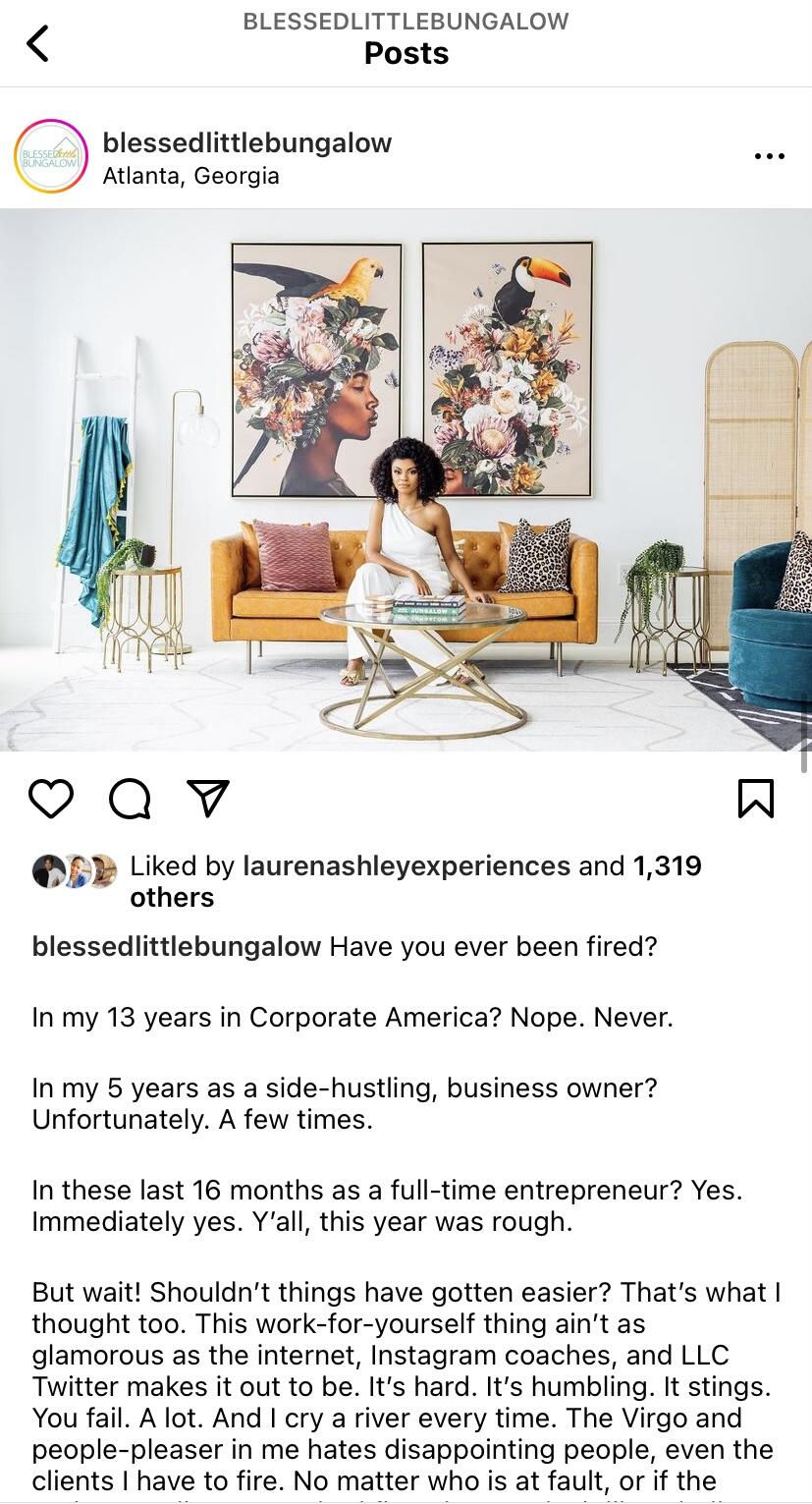
I haven’t arrived at a point where I feel like anything is off-limits—even my religion, for example. My page is called Blessed Little Bungalow, so people assume I’m Christian, and I have no problem talking about my faith and God and so on. If that makes someone uncomfortable, when they see my handle, they probably should not have followed. I just try to keep things as human as possible. I can’t remember what I posted, but I had someone DM me one time saying I need to stick to posting about design—like, “I don’t want to hear about this political thing.” And I’m like, “Well, when there’s a school shooting, I’m not going to post about this living room.” I’m not a robot, I’m a human. And if folks are like, “I didn’t come here for that,” then follow somebody else. I think that being human and being real about those things—that’s what pulls people in versus turns people off. My organic growth has just been a testament to me doing my best to be myself.
Do you have a personal account in addition to Blessed Little Bungalow?
I do have a personal Instagram, but lately I haven’t been using it nearly as much as I used to. I feel like all I do on my personal account is repost memes and videos. But I do keep the accounts separate, and I don’t see myself ever getting rid of one or the other. At High Point Market [this fall], Justina Blakeney was talking [in a keynote presentation] about why she has a Justina Blakeney account and a Jungalow account [that are both for her businesses], and I’ve even thought about that too—like, I wonder if I’ll ever get to a point where I have an Amber Guyton Design account separate from Blessed Little Bungalow. She was talking about still having her own presence and community following her name, which is also trademarked separately, even if she ever sold Jungalow. I have seen other designers and influencers who initially had their handle as one thing, and then they changed it to their government name as an ownership thing for their brand on Instagram.
What does the process of producing content look like for you?
For client projects, I always get the “before” photos of what the space looks like at the first consultation, and in the past year or two, I’ve tried getting “before” video too. I also get process photos—what it looks like once a wall is painted or once a sofa is delivered. It’s just like a story: You want a beginning, a middle and an end.
Sharing the process is so important—for example, if a sofa was actually not the best scale for the room, but we turned it this way [to make it work]. I try to document things I might not have thought about in the beginning of the project that shifted or pivoted during the process, and to have visuals of that. Also, because I still blog about my projects, being able to share the shopping trips and deliveries in pictures and words is helpful. I also have professional photos taken after the project is over so I can have some clean, beautiful images for my website portfolio and social media. When I reveal newly completed projects, I do so along with a blog post, and then I have images, Reels or videos on Instagram.
There are also times when I’ve gone to Trader Joe’s, bought a bunch of flowers, and I’m making a floral arrangement. And I’ll just put my phone on my tripod and capture a time-lapse of me cutting the flowers and putting them in a vase, and then there’s some fun music or motivational speech or something over it. That’s a Reel that I could post on Saturday morning.
A lot of it is in the moment, but the most deliberate things are, “OK, I’m going to pay X amount of dollars to get this space shot, and then I’m going to take the time to write the caption about the preview of the blog post for this project.” Because I want to keep things in my voice and be as authentic as possible, a lot of my posts are in the moment—very few are scripted. The only things written ahead of time are brand partnerships that had to be approved—and even then, I don’t want it to feel rehearsed at all. I want it to feel like they can read it and hear my voice.
Do you use any special camera equipment, apps or scheduling services?
When I first started Blessed Little Bungalow, I was like, “I’m going to buy a DSLR camera and learn how to be a photographer.” That lasted all of two seconds. Although I bought a mirrorless camera, it’s still in the bag in some closet. Because even though you can do it all—and I’ve even taken a photography class before—it’s like, let the experts do what their expertise is. Hiring photographers for my lifestyle portraits and interior photography is something I budget for, and it’s something that’s important to me.
As far as shooting photos myself, I just use my iPhone. I have a few apps that I use, like Snapseed and Lightroom for editing photos. For videos, I’ll sometimes use InShot—but honestly, Instagram has evolved so much that sometimes I’m just creating things in the app. As far as text and graphic stuff, Canva is pretty user-friendly. There’s not much you need outside of your smartphone to make beautiful content on social media these days.
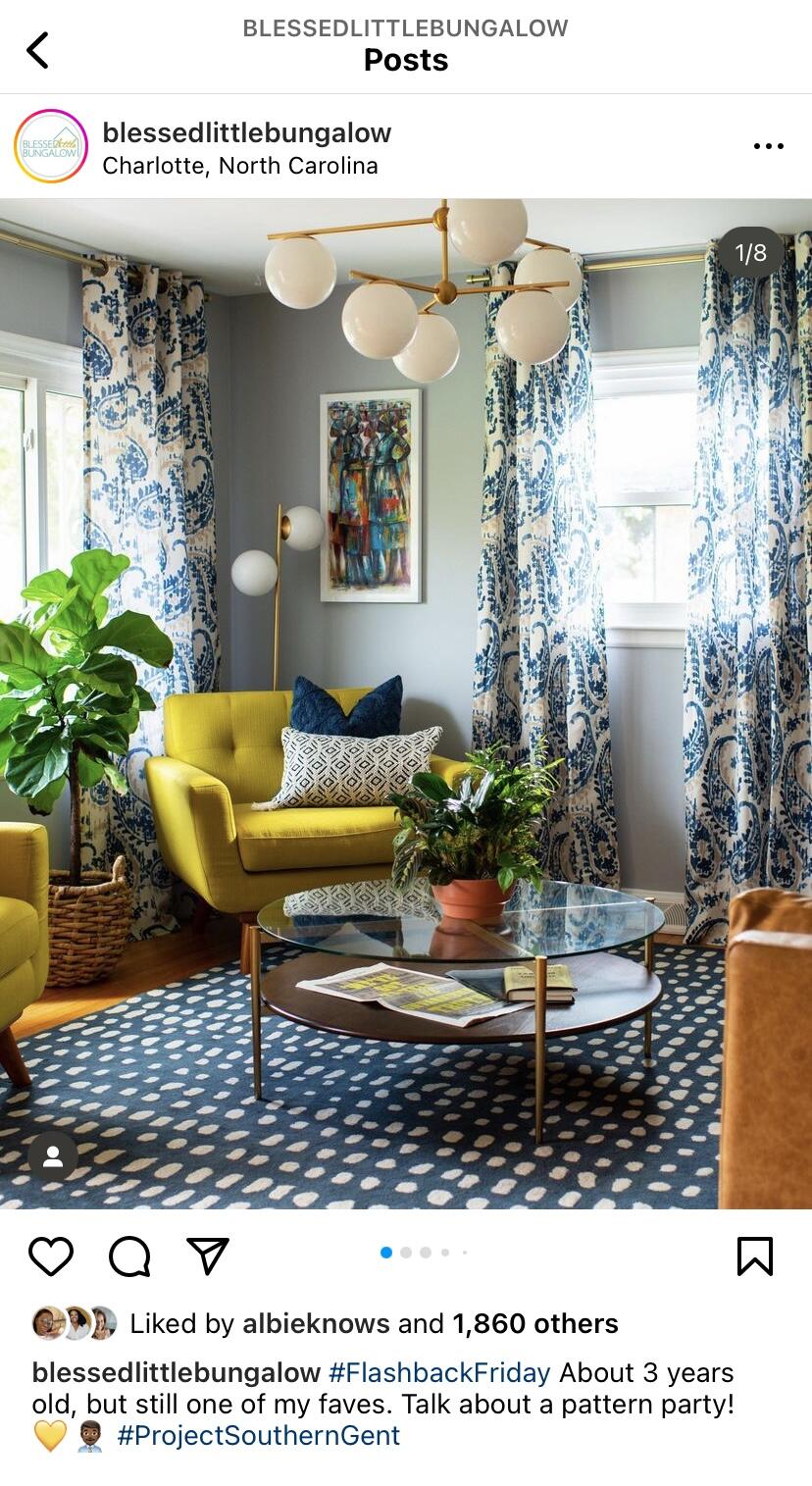
How do you work with brands?
For a long time—up until this summer—the partnerships had all been inbound. I hadn’t taken the time to pitch brands and say, “Hey, Home Depot, I’m working on this. I would love for you to pay me X amount and give me this free equipment so I can execute it and tag you along the way.” Even though my background is marketing and I’m comfortable writing a pitch email, everything that I have done has been because the brand came to me and said, “We love your work. We’d love to offer you X, Y and Z in exchange for content.” That has been fun, because of course it’s another stream of income—and it’s more visibility, especially if they’re reposting you. But it’s also been an easy transition, because I’ve always posted about and tagged relevant brands. A lot of my projects include furniture from West Elm, Crate & Barrel and CB2, and I’m always tagging them regardless of whether we have a formal relationship because for a lot of my followers, their first question is, “Where did that come from?”
[Posting resources] is a bit controversial. A lot of designers don’t tag anybody, and they won’t reveal any vendors, either because it’s trade-only [product] or they’re like, “I’m not getting paid by this person.” Some designers see it as a disservice to their clients: “They paid me to pick these things out. I’m not going to give that information away for free just because someone asks.” But I have always tagged anything and everything, and I feel like that’s how I’ve gotten a lot of brands’ attention. I’m also using their hashtags—for CB2, it may be #CB2 or #CB2style, whatever hashtag is in their profile. That leads to them sharing the work on their page or in their Stories, so there’s definitely a benefit to communicating with, tagging and engaging those brands. And then if you ever do pitch them, or if they want to work with you, they can go back and see that you’ve already been building a relationship with them. After doing that for about six years, I’m now doing paid partnerships with brands like Wayfair. But any brand that I partner with is going to have to be a brand I already use.
How do you decide your rates for partnerships and content?
There are a lot of formulas out there, based on how many followers you have, that tell you how much you should be charging for a certain post. I recently started working with a PR agency, and they’re helping to lead me in those negotiations and decide what my rates should be. But when I was first starting out, it was like, “Oh, you’re giving me free products, thank you!” My career prior to Blessed Little Bungalow was a full-time job in financial services—I worked in banking and mortgages—so the money that I started making with Blessed Little Bungalow was a side hustle at first. It was fun money for my travels or to buy new furniture. And since I had about $100,000 of debt, between student loans, credit cards, car payments and some other stuff, I just threw all my Blessed Little Bungalow money at that for years.
My main stream of income today is my client projects, but especially with my recent growth in followers, pricing has definitely increased for posts. Last year, I had just hit 20,000 followers on Instagram, and then earlier this year, I hit 40,000. Posting Reels and the algorithm have definitely fueled the snowball of my followers. At first I was like, “Oh, if I could just hit 50,000 followers this year, that’d be great, because then I would have doubled from last year,” but then I actually quadrupled that number because of some posts going viral and the fact that I was in HGTV Magazine for the first time in September. And it’s a lot of work. I feel like people just see, “Oh, you made a Reel, and you got $4,000 for it.” But the amount of time it really takes—you don’t see me editing things, or what it costs if you have to hire a videographer or photographer. And yes, they send you this free product, but you actually have to receive it and stage it, and it’s time-consuming.
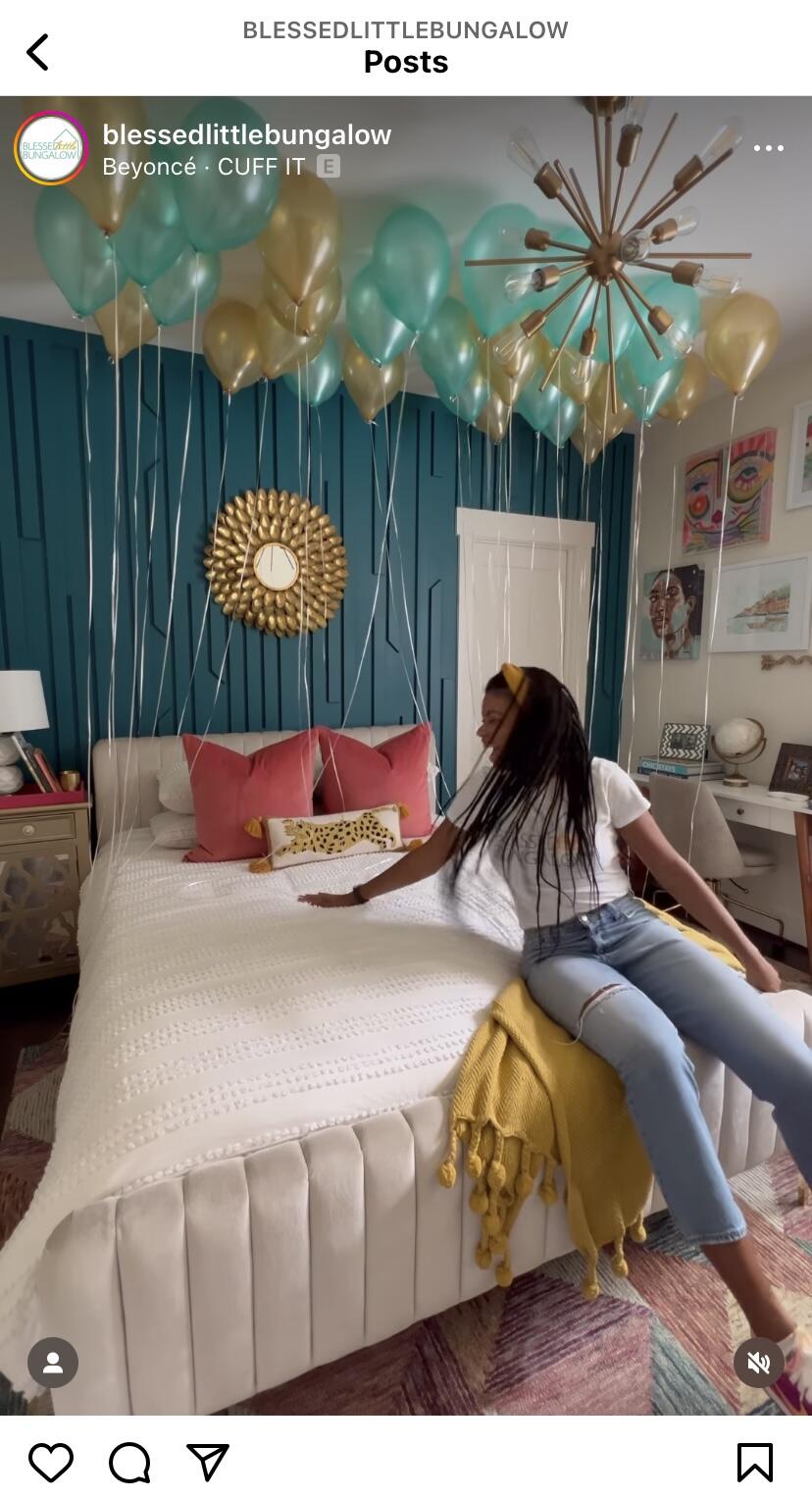
When you started to become a public figure on social media, did your everyday life change?
I think the phrase is, “It takes a decade to become an overnight success,” and it’s almost been a decade. It’s funny how I can be out somewhere—in Starbucks for example—and someone will come up to me like, “Oh, my gosh, Blessed Little Bungalow, I love your work!” You forget that there are eyeballs on the other side of what you’re doing. There was also a moment during High Point Market when this lady came up to me and was like, “I just want to let you know, keep doing what you’re doing. You don’t know how many people you’re helping by sharing so much of your story and your journey.” She had me in tears because I’ve really been struggling personally and professionally, and there are moments when you forget how much good is happening.
That’s all I ever wanted to do in the interior design space: Help people find joy in their own homes, and help them see themselves in their house. And I think as an influencer and content creator, it’s the same thing. I want you to see what I’m doing, and to have it encourage you to chase your dreams. You can take that leap of faith and do what you love, and survive and thrive from it.
What’s the biggest challenge for you right now when it comes to your social media activity?
This has been the year of everyone being annoyed with the Instagram algorithm. “I posted this, and only 2 percent of my followers actually saw it.” Or it was the glitches, or new updates, or just feeling like you’d spent so much time on something and it fell on deaf ears. It’s very easy to feel defeated. One minute you feel like you’ve figured it out—and then something changes and that [approach] might fall flat. Being adaptable, not taking yourself too seriously, and not [looking to] the world to validate you—the world will validate you, but don’t put all of your happiness into that bucket.
It’s also important to adapt to the platform because we don’t own the platforms. The only thing I own is Blessed Little Bungalow on Squarespace, my email list, the documentation and things that I have for my work—everything else is owned by someone else. As much as I feel like my Instagram presence and followers are important to my brand, I have to move in a way that [allows for], “What if your account gets hacked tomorrow, and you lose your Instagram page? You’re still Amber, you’re still Blessed Little Bungalow, you still have your clients, your press and all of these other things.”
You also can’t do things that aren’t authentic, because they’re going to fall flat. You want to cater to the audience you have and do things that are true to yourself. I feel like that’s something that I have to commit to every day. There are some days I just don’t want to post, and I won’t. And there are some days where I’m just like, “I need to share this experience,” so I write this two-paragraph caption and then take a nap and wake up, and it has 1,700 likes. So just do it. Just put it out in the world and see how your audience responds, and adjust accordingly.
Homepage image: Amber Guyton | Courtesy of Amber Guyton
















